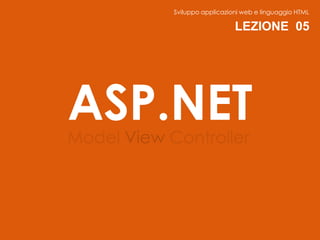
ASP.NET MVC 3 - Presentare i dati nella View
- 1. Sviluppo applicazioni web e linguaggio HTML LEZIONE 05 ASP.NET Model View Controller
- 2. Model
- 3. Con le View mostriamo i dati all’utente
- 4. Quali dati?
- 5. Quelli del model …
- 6. Quelli del model … Visualizziamo in homepage il numero totale di post e commenti utilizzando il DbContext
- 7. Quelli del model … Visualizziamo in homepage il numero totale di post e commenti utilizzando il DbContext e LINQ to Entities int totalPosts = 0, totalComments = 0; using (var db = new BlogContext()) { totalComments = db.Comments.Count(); totalPosts = (from p in db.Posts where p.IsPublished select p).Count(); }
- 8. … e nella vista i dati come li trasportiamo?
- 10. ViewBag dynamic al quale possiamo assegnare proprietà arbitrarie
- 11. ViewBag.TotalPosts dynamic al quale possiamo assegnare proprietà arbitrarie
- 12. ViewBag.TotalPosts int totalPosts = 0, totalComments = 0; using (var db = new BlogContext()) { totalComments = db.Comments.Count(); totalPosts = (from p in db.Posts where p.IsPublished select p).Count(); } ViewBag.TotalPosts = totalPosts; ViewBag.TotalComments = totalComments;
- 13. In realtà … Il ViewBag permette di rendere dinamico l’accesso ad un dizionario, il ViewData
- 14. ViewBag.TotalPosts int totalPosts = 0, totalComments = 0; using (var db = new BlogContext()) { totalComments = db.Comments.Count(); totalPosts = (from p in db.Posts where p.IsPublished select p).Count(); } ViewBag.TotalPosts = totalPosts; ViewData[“TotalComments”] = totalComments;
- 15. ma vediamo come nella vista i dati del model si mescolano al codice html …
- 16. ma vediamo come nella vista i dati del model si mescolano al codice html …
- 17. Questa sintassi in esecuzione viene interpretata da un View Engine
- 18. Questa sintassi in esecuzione viene interpretata da un View Engine, che ha il compito di tradurre il codice sottostante nell’html da inviare al browser.
- 19. Questa sintassi in esecuzione viene interpretata da un View Engine, che ha il compito di tradurre il codice sottostante nell’html da inviare al browser. Il View Engine in questione si chiama Razor
- 20. Mostriamo in home gli ultimi post:
- 21. Mostriamo in home gli ultimi post: 1 var posts = ( from p in db.Posts where p.IsPublished orderby p.CreatedDate descending select p ).Skip(0) .Take(3) .ToList<Post>();
- 22. Mostriamo in home gli ultimi post: var posts = ( from p in db.Posts where p.IsPublished orderby p.CreatedDate descending select p ).Skip(0) .Take(3) .ToList<Post>(); 2 ViewBag.Posts = posts;
- 23. Mostriamo in home gli ultimi post: var posts = ( from p in db.Posts where p.IsPublished orderby p.CreatedDate descending select p ).Skip(0) .Take(3) .ToList<Post>(); ViewBag.Posts = posts; 3 @foreach (var item in (IList<Post>)ViewBag.Posts) { <h2>@item.Title</h2> <h3>Pubblicato il @item.PublishedDate</h3> <p>@item.Body</p> <p class="tags">@item.Tags</p> }
- 24. Il ViewBag è molto comodo, ma ci costringe a eseguire sempre un cast prima di utilizzarlo se la proprietà è un oggetto complesso @foreach (var item in (IList<Post>)ViewBag.Posts) { <h2>@item.Title</h2> <h3>Pubblicato il @item.PublishedDate</h3> <p>@item.Body</p> <p class="tags">@item.Tags</p> }
- 25. Strongly-typed views Possiamo dire alla vista il tipo del modello che gli passiamo
- 26. Strongly-typed views public ActionResult Index() { … var posts = …; ViewBag.Posts = posts; return View(posts); }
- 27. Strongly-typed views @using WebApp.Blog.Domain.Model; @model IList<Post> @foreach(var item in Model) { …
- 28. Blocco di codice: @{ ViewBag.Title = "Home Page"; }
- 29. Espressione con html encoding <h2>@item.Title</h2>
- 31. Chiamata di un metodo <p>@(DateTime.Now.ToLocalTime()))</p>
- 32. Controllo del flusso @foreach (var item in Model) { <h2>@item.Title</h2> <p>@item.Body</p> <p class="tags">@item.Tags</p> }
- 33. Mescolare codice e testo @foreach (var item in Model) { <h2>@item.Title</h2> <p>@item.Body</p> <p class="tags">@item.Tags</p> <text>Copyright - 2012</text> }
- 34. Layout Selezionando le parti comuni tra le pagine del nostro sito possiamo definire un layout e delle sezioni da riutilizzare
- 35. Layout <!DOCTYPE html> <html> <head><title>@ViewBag.Title</title></head> <body> <header> <h1>My MVC Application</h1> </header> <section id="main"> @RenderBody() </section> <footer>@RenderSection("Footer")</footer> </body> </html>
- 36. Layout <!DOCTYPE html> <html> <head><title>@ViewBag.Title</title></head> <body> <header> <h1>My MVC Application</h1> </header> <section id="main"> @RenderBody() </section> <footer>@RenderSection("Footer")</footer> </body> </html>
- 37. Layout <!DOCTYPE html> <html> <head><title>@ViewBag.Title</title></head> <body> <header> <h1>My MVC Application</h1> </header> <section id="main"> @RenderBody() </section> <footer>@RenderSection("Footer")</footer> </body> </html>
- 38. Layout Come faccio a fare in modo che la vista utilizzi un determinato layout? @{ ViewBag.Title = "Home Page"; Layout = "~/Views/Shared/_Layout.cshtml"; }
- 39. Layout Ma lo devo fare per ogni vista?!
- 40. Layout Ma lo devo fare per ogni vista?! NO, basta utilizzare il ViewStart …
- 41. _ViewStart E’ un file che viene inserito nella cartella principale e permette di far applicare delle regole a tutte le viste presenti in quella cartella e in tutte le sue sottocartelle
- 42. PartialView Se le informazioni da visualizzare sono le stesse (o quasi) per molte pagine, allora possiamo creare una “vista parziale” che le contenga
- 43. PartialView Nel layout o nella view <footer>@Html.Partial("Footer")</footer> In un file con nome Footer.cshtml (sotto la cartella ~/Shared ) <p>Copyright © 2012</p>
- 44. RenderAction Se non mi basta la vista parziale posso ricorrere alle “child action”
- 45. RenderAction 1 @{ Html.RenderAction("List", "Category"); } All’interno di una vista
- 46. RenderAction Come action di un controller 2 public ActionResult List() { IList<Category> cat_s = new List<Category>(); using (var db = new BlogContext()) { cat_s = (from c in db.Categories.Include("Posts") select c).ToList<Category>(); } return PartialView(categories); }
- 47. Codice di markup RenderAction della partialview 3 @using WebApp.Blog.Domain.Model; @model ICollection<Category> <h2>Categorie</h2> <ul> @foreach (var item in Model) { <li> @item.Name (@(item.Posts != null ? item.Posts.Count() : 0)) </li> } </ul>
- 48. Come esercizio: Una pagina che visualizzi tutti i post di una categoria Una pagina che mostri i dati di un post compresi i commenti Paginare l’home page per mostrare i post meno recenti
- 49. continua …
- 50. Credits Le immagini contenute in questa presentazione hanno licenza Creative Commons Slide 10: http://www.flickr.com/photos/jeffwerner/2677245039/in/photostream/ Slide 13: http://www.flickr.com/photos/philthomas/3345060816/in/photostream/
- 51. Thank You MANUEL SCAPOLAN website: www.manuelscapolan.it twitter: manuelscapolan e-mail: info@manuelscapolan.it
